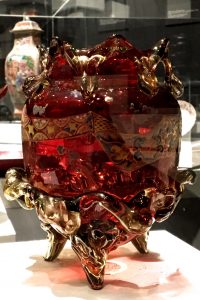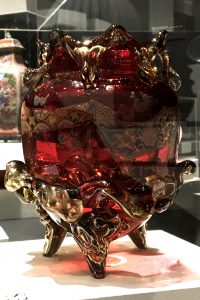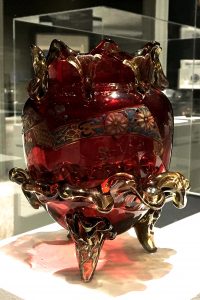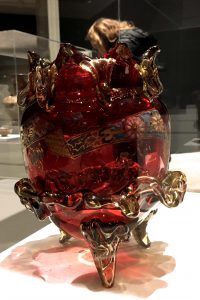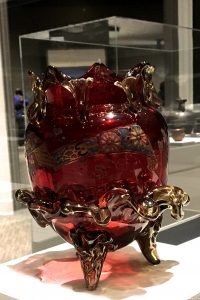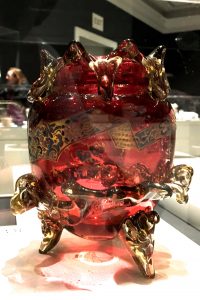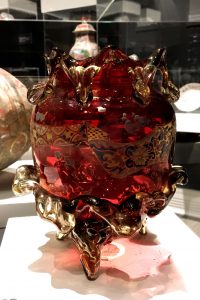Vase with Japanese-style Decoration, c. 1880 by Auguste Jean
Standing atop its three feet, the glass vessel, Vase with Japanese-style Decoration, beckons a viewer closer with is primary cherry-red pigmentation and golden embellishments. The body of the vessel is a striking red whose transparent qualities make use of light through exploiting the imbued color of the glass, creating dimension by forming shadows and gradations of color intensity, while the added golden glass features similarly make use of light to call attention to their sheen and sense of opulence. Its feet, as well as its skirt and lip trimmings, resemble what could be likened to a folded yellow-caramel colored curtain, as the adorning pieces of glass maintain a distinct stiffness that echoes the shapes of a folded cloth. In large part, the significant use made of the light that envelops the vessel to further enhance the already-established sentiments of gilded, draped opulence is a method employed by the artist, Auguste Jean, that is similar to that which is characteristic of the Blaschka flowers and marine life pieces: a keen manipulation of light and its interplay with the transparent qualities of glass are employed as key modes of establishing qualities central to each piece’s desired final form.
The vessel appears as if it were made using originally colored glass: warm caramel-colored glass was used for the ornamental details of the piece, such as for its feet and embellished lip and skirt, while a vibrant, cherry-red glass was used for the piece’s body. Given the uniformity of the body of the vessel, it seems likely that the cherry-red glass portion would have been blown, then either weighted or somehow otherwise pulled to establish an elongated, almost oval- or egg -shaped body, and then cut at the top to create a wider diameter for the piece’s mouth. Further, since the sloping nature of the piece’s body abruptly stops curving and rather turns upward vertically to form a band that continues around the entirety of the mouth, it can be assumed that the two distinct portions of red glass would have either been made to take such a shape by having been manipulated with tools when still hot enough to be malleable, or by having been constructed separately and later joined through re-heating both portions of the glass body to fuse them together. The golden-toned glass looks as if it had been shaped when hot enough to be manipulated with hand-held tools to achieve the desired folded appearance while still being viscous enough to establish functionality in its final form (e.g. the stability of the standing three legs, which are reasonably uniform in height while retaining a folded, dripping appearance). It is clear that the legs, lip, and skirt were adhered to the red body via a heating process that fused the pieces together, as seams are apparent between the two differently colored pieces of glass that still look as if they melt into one another. The enamel gilded, floral motif is most likely to have been added at the very end of the making and assembly process, given the overall fragility of the piece and the propensity for enamel to wear off easily with use. The red body of the vessel was decorated across its widest points with Asian-inspired floral embellishments against a backdrop of a silky golden wash of enamel. These floral elements conjure notions of cherry blossoms, calling to mind more exquisitely produced Japanese works that do the same, which are set beside other designs (particularly the blue forms) that feel rather European.
Given that red and gold are the piece’s predominant colors and that the painted motifs that emblazon the vessel’s exterior walls suggest to be Japanese, it seems as though the vessel is intended to evoke Asian art. These distinctly Asian artistic color palettes and themes are interestingly juxtaposed with the glass’ transparency — the medium’s most prevalently exploited property — calling attention to the artist’s choice of exploiting, rather than trying to avoid the expression of, the ephemerality of translucency. In fact, this particular material manipulation almost signifies to the viewer that this vessel is merely an imitation of Asian art—it is faux in its very nature: an assumption corroborated by the name of the artist, Auguste Jean, who is, indeed, a late-19th and early-20th century French artist.
The glass vessel seems to be primarily decorative in function, although its particular utility does appear to have been harnessed at points in its history, as the facade of the piece has clearly seen some use (as made apparent by what looks as if it is worn enamel, mainly in the front-facing region). Thus, the vessel could reasonably be assumed to have been used as a vase to house cut flowers or other decorative items, making use of its form and the properties of the glass medium that not only allow heated glass to take a rather uniform elongated-cylindrical shape via glass blowing and forming but also that enable water to remain within the ultimate form without worry of its seeping out. Although the description of the item confirms its likely use as a vase by having designated it as such (indeed, its title is Vase with Japanese-style Decoration), the vessel still could have theoretically not been used exclusively in this way, and rather only take a shape that is most easily described by the titular description of “vase.”
To be sure, the era in which this piece was made (circa 1880) can be noted for the increased social and cultural globalization that took place. Particularly in Europe, as we have discussed in many of our classes, there was a pervasive material obsession with the “exotic.” Given that many materials were either unavailable due to location-based rarity or extravagant prices, while particular production processes were held clandestine by their parent-societies, the notion of mimicry pieces (both in terms of artistic design and material form) flourished. Indeed, the notion of a “typical type” of Asian design proliferated in European communities that yearned for the pieces that truly hailed from faraway lands and that, in turn, sought imitations of such works that used more readily accessible mediums, such as glass, and employed embellishment techniques that could mimic Asian influences. In a time when artisans aimed to replicate desired skills of their cross-seas counterparts, it is feasible that the commissioner of Vase with Japanese-style Decoration (or even the artist himself) yearned for original Japanese pieces, and thus aimed to mimic such pieces through the use of a more accessible medium that was better understood in Europe (i.e. glass) and then, via the use of enameling techniques, detailed the piece with semi-intricate Asian-inspired designs.
